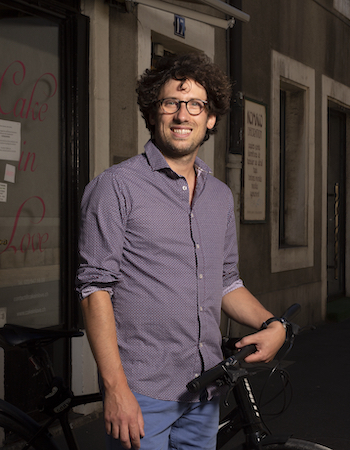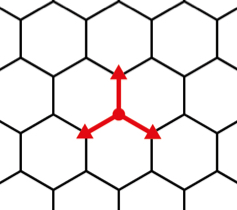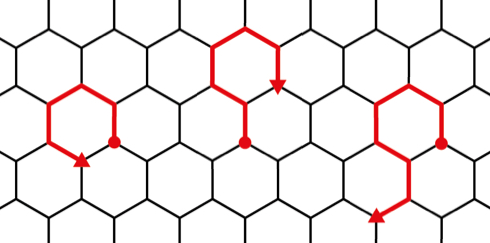
The Fields Medals 2022: Hugo Duminil-Copin
You can read a shorter version of this article here.

Hugo Duminil-Copin (Photo Matteo Fieni)
Hugo Duminil-Copin, a mathematician from the University of Geneva, has won one of this year's Fields Medals at the International Congress of Mathematicians. The Fields Medal is one of the most prestigious prizes in mathematics. It is awarded every four years "to recognise outstanding mathematical achievement for existing work and for the promise of future achievement". Up to four mathematicians up to the age of 40 are awarded a Fields Medal each time.
We were lucky to talk to Duminil-Copin in the run-up to this year's Congress, which is held as a fully virtual event with only the prize ceremonies and lectures taking place in-person in Helsinki, Finland. He told us about how his work in statistical physics brings together his two loves – maths and physics.
Happiness at the crossroads
"I always had this balance, of these two loves, and not really knowing how to reconcile them," says Duminil-Copin as he describes his attraction to working on physics and working on maths. Like many kids he wanted to understand how the world works and why it works that way. But he was also strongly drawn to the reassuring purity and finality offered by mathematical proofs, where you could build a "castle that wouldn't collapse, that wasn't made of cards."
Although he chose to study maths, Duminil-Copin soon happily discovered the area of statistical physics, where probability theory is used to understand physical phenomena. "For me it was 'Oh my god what just happened!' Something I was looking for for years was just in front of me, an area at the crossroads of the two things I wanted!"
Phase transitions and universality
See here for all our coverage of the ICM 2022 and the prizes awarded there.
Duminil-Copin has been recognised for his work transforming the mathematical theory of phase transitions in statistical physics. Phase transitions are something we're all familiar with – an example is water freezing to ice when it falls below zero degrees temperature. A phase transition is when a complicated system, like a bunch of water molecules, undergoes some drastic change of behaviour as some parameter, in this case temperature, passes some critical point.
"What we do as mathematicians is we try to understand how these phase transitions occur by making mathematical caricatures of the physical phenomenon," says Duminil-Copin. An example of such a mathematical caricature (otherwise known as a mathematical model) is using a regular lattice to describe the arrangement of the system you're trying to understand. In reality there are no real constraints on the positions of the molecules in liquid water, they don't lie regularly in space in a way you could realistically describe using the points on a lattice. But in order to study this system it's often simpler to imagine that the molecules are regularly positioned in this way.
Although such an assumption is deeply unrealistic, Duminil-Copin says that studying the system this way allows you to explain the phenomena that are actually occurring. "It's something related to a very deep phenomenon – universality – that I try to understand as a mathematician."
Universality is almost like wishful thinking come true: in certain situations the fine details of your mathematical model don't affect its global behaviour. The reason is that if a system involves many different random processes, such as many water molecules moving around, then the details of the underlying mechanisms should not matter. In the example of water freezing to ice, you can choose whatever arrangement of molecules you like – assume they are positioned regularly in a lattice of your choosing – and the phase transition you are studying will have the same properties regardless of your choice of lattice.
"This is very reassuring for mathematicians and physicists because it tells you that many systems in the end have the same behaviour, and you can choose the simplest example of such systems, which is those that lie on a lattice." Mathematically you can get a lot more out of this much simpler description of the problem. The mathematical model isn't necessarily representative of the physical reality, but thanks to universality you're still going to end up with the same results as if you'd started off with a physically accurate description.
Beautiful problems
Statistical physics offers problems that Duminil-Copin is particularly drawn to: ones that are deceptively simple to state but require new mathematics to solve. He told us about one example that was one of the first conjectures he learned about when he was a postdoctoral student.

There are three self-avoiding walks of length 1. (Image by Charles Trevelyan)
"Imagine you are in front of a bee hive," says Duminil-Copin. The front of the beehive forms a hexagonal tiling of the plane, and the corners and lines marking the walls of the beehive form the points and edges of a hexagonal or honeycomb lattice. Imagine you choose a starting point in the lattice and then pick your path across the lattice following one simple rule: you can not return to any place on the lattice you have already been. This is called a self-avoiding walk.
Where can you go? You have three choices for your first step. Then you'll only have two choices for your second step, as you can't retread your steps. And for similar reasons you have two choices for each of your third, fourth and fifth steps. But by your sixth step things start getting complicated and you have to be more careful, as you could potentially start completely loops of hexagons.

Examples of self-avoiding walks of length 5, 6 and 7. (Image by Charles Trevelyan)
We can personally attest to how engrossing it is to think through all the possible self-avoiding walks (SAW) for these relatively small numbers of steps. As Duminil-Copin says, the rules are so straightforward a child can do it, but the complexity of the problem quickly appears. It's clear the number of possible SAWs grows exponentially with the number of steps taken, but as you take more steps it's increasingly hard to keep track of this number as you try to make sure you never retread your steps. "You realise very quickly that you cannot compute exactly this number, it's a very difficult number to grasp."
| n : the number steps taken | Cn : the number of possible SAWs of length n |
|---|---|
| 1 | 3 |
| 2 | 2 x C1 = 6 |
| 3 | 2 x C2 = 12 |
| 4 | 2 x C3 = 24 |
| 5 | 2 x C4 = 48 |
| 6 | 2 x C5 - 3 x 2 = 90 |
| 7 | 2 x C6 - 3 x 2 = 174 |
Counting the first few self-avoiding walks
This problem isn't just a fun distraction when you're supposed to be writing an article. In the 1940s chemists Paul Flory (who won the Nobel Prize for Chemistry in 1974) and W.J.C. Orr introduced SAWs as a way to study long chain-like molecules – polymers – and understand how they behave. "It's very related to physical phenomena, for example trying to understand what polymers, such as DNA molecules, are doing. These polymers are self-avoiding [walks] for obvious reasons: they are long sequences of molecules that can't be at the same place."
There's no exact answer known for how fast the number of SAWs grow on any lattice, whether the honeycomb lattice we've thought about above, or a square or triangular lattice of the plane, or a cubic lattice of three-dimensional space. But unique among these lattices, for the honeycomb lattice, we can get very close to an answer . In 1980 the statistical physicist Bernard Nienhuis conjectured that the rate of growth of the number of SAWs on a honeycomb lattice is almost $(\sqrt{2+\sqrt{2}})^n$ for a large number of steps $n$.
"I found it truly fantastic that there is an answer, and it's a really cool number!" Duminil-Copin says. "This was a conjecture I first learned about in my masters class. It's funny because at the time it looked like there was no hope the conjecture could be proved – I discussed it with my PhD supervisor and we both agreed it was a terrible idea to try to prove it."
Because the conjecture involves counting things, it might sound like the proof should involve combinatorics, an area of maths that is all about counting. But the answer ended up coming from a very different area of maths. Duminil-Copin was working on problems in complex analysis, seemingly disconnected with self-avoiding walks, when he started to understand some of the ideas that arose in the conjecture. "At some point it just started snowballing and we got this cool proof," he says. (You can get into some of the details of this proof in this lovely article by Duminil-Copin.) "This is a typical example of problems that we have in our field where you get inspired by many other fields of mathematics and physics. It puts you at the crossroads of many places [and] that is something I like very much."
More symmetry at the point of change
Duminil-Copin is very happy to be working at this crossroads of mathematics and physics. Initially it was physicists who made most progress in understanding phase transitions, but "now it's almost like the other way around, where the mathematical [contribution] is very strong."
One example is the recent progress by Duminil-Copin and colleagues in understanding something called conformal invariance, a particularly rich set of symmetries that may be present in a mathematical model describing a physical system. The reason that symmetries are useful is that they reduce the amount of information you need to describe the model. To describe a chessboard, for example, all you need to say is that black and white squares are arranged in a lattice so that the colours alternate. If you can reduce the amount of information you need to describe a model, then this also means that the model's behaviour at critical points can be described more precisely.
Proving conformal invariance has been a very active research area, but since 2000 only a handful of specific models (for example, for just a few particular types of lattices) have been rigorously proved to be conformally invariant. "There was a list that could be counted on one hand of models that were conformally invariant," says Duminil-Copin.
To make things easier Duminil-Copin and his colleagues only considered models that live in two dimensions, rather than full three-dimensional space. "The understanding of conformal invariance in two dimensions for mathematicians has progressed so much that it is now shedding new light on the physical theory," he says.
As further simplification, they only focussed on rotational symmetries. To see what this means, consider our example of SAWs on a honeycomb lattice. Suppose you are interested in the number of SAWs between a starting and finishing point on your lattice. Then it's clear that this number will be the same if you rotated your finishing point by a third of a circle around the starting point – that's just a symmetry inherent in the lattice itself.
"One marvellous property of systems at criticality, basically when phase transitions occur, is that the system gains more symmetries," says Duminil-Copin. As a consequence it was believed that a system undergoing a phase transition would become rotationally invariant under any angle, not just the obvious one you see far away from criticality.
Duminil-Copin and colleagues were able to provide a rigorous mathematical proof of this rotational symmetry for a much larger group of models. What's more, their methods could provide the missing ingredient that could lead to proofs of full conformal invariance, and all the mathematical power this would bring.
Sharing mathematics
Mathematics by its nature enables easy collaboration: you don't need some vast experimental apparatus to show your ideas, you can just talk about your ideas over coffee. And collaboration is a key part of how Duminil-Copin works as a mathematician. Interacting with people with different experiences, people who can see your work from a different angle, can turn a problem from being totally doomed to becoming a marvellous idea. "It's this kind of constant interaction and improvement of everybody's ideas that makes maths what it is today."
Duminil-Copin sees his Fields Medal as recognition for all of those working in his area and the work they are developing together, and he cannot wait to finally share this recognition with his collaborators when the prizes are announced at the ICM. "Mathematics is a very social activity, much more than people believe" he says. "There is this image of the mathematician as the lonely hero, but in my case it's not a vision of my mathematics or my way of doing mathematics. My work would not happen without this interaction with others." Congratulations to Duminil-Copin and to all his collaborators on this prize!
About this article
Marianne Freiberger and Rachel Thomas, Editors of Plus, interviewed Hugo Duminil-Copin in June 2022.This content was produced as part of our collaborations with the London Mathematical Society and the the Isaac Newton Institute for Mathematical Sciences. You can find all our content on the 2022 International Congress of Mathematicians here.

